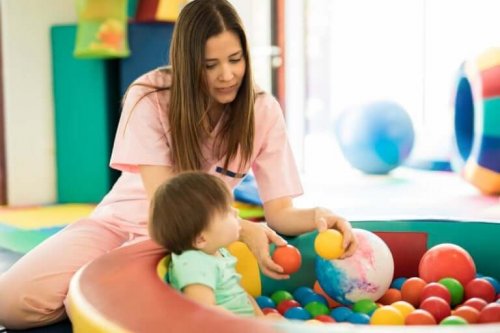Early Childhood Intervention for Children with Special Needs

Today, there are many professionals who are dedicated to early childhood intervention for children with special needs. They provide much needed help to children with disabilities and their families.
To achieve a good prognosis and evolutionary development in children, it’s ideal to treat their difficulties when they’re babies. Additionally, the family requires help to solve their doubts and concerns. This will also teach them how to help their children through simple everyday actions.
Early childhood intervention is a service that evaluates the characteristics of children as well as their environment. Once the information has been collected, a personalized intervention is proposed to help the children evolve and develop their skills.
What is early childhood intervention?
Early childhood intervention consists of carrying out a set of interventions with children between the ages of 0 and 6. These kids usually have certain temporary or permanent needs. These can be due to the presence of a developmental disorder or having a risk of suffering from one.
Above all, these interventions must be planned by a team of professionals from different disciplines specialized in:
- Psychotherapy and psychological support.
- Speech therapy.
- Physiotherapy.
- Psychomotor.
- Early stimulation.
The specialists must also work as a team to achieve the goals set in the different areas of development and get the best possible care in all areas of the children’s lives.
With that in mind, we must take into account that there are two models for early childhood intervention that are currently being put in place:
- Ecological model – based on the children’s relationship and interaction with their environment. Therefore, it implies that the family and the nearby environment (school, health center, etc.) should participate in the intervention.
- Biopsychosocial model – refers to the importance of developing the children’s integration in the family, school, and social environment, as well as their personal autonomy.

Early detection in children with special needs
Early detection is undoubtedly essential to begin a therapeutic intervention. It’s important to look for and observe certain warning signs that may indicate the presence of any developmental child disorder.
In case of suspicion, you must seek the help of professionals to provide a diagnosis. They must assess biological, psychological, social, and also educational aspects. Hence, the evaluation should consider the following:
- The evolutionary development of the child. Communication skills, socio-emotional development, cognitive processes, learning style, psychomotor development, ability to respond to the environment, game skills, etc.
- The characteristics of their family and social context. Economic and sociocultural status, risk of abuse or negligence, etc.
- The relationship established with their parents. Need for information, family unrest, resource needs, level of trust, etc.
Doing this won’t only give value to the children’s individual aspects and difficulties, but you’ll also take into account how their environment affects their development.
Early childhood intervention for children with special needs
Once the professionals establish a diagnosis, it’s time for the intervention.
To carry out a good child intervention, professionals have to follow the White Paper on Early Childhood Intervention. This document was prepared by the Grupo de Atencion Temprana (G.A.T.) in order to serve as a reference for public administrations, professionals, associations, and families.
In general, an individualized program for the intervention must be prepared for each child. Thus, it has to consider their needs and possibilities in four areas of development:
- Motor skills
- Perceptual-cognitive abilities
- Socio-communicative abilities
- Autonomy
The program must certainly include the timing of the objectives, the methodology and evaluation, and the monitoring of the results they obtain.
Early childhood intervention for families and school
During the intervention, the professionals have to support the families, teach them competencies for the education and interpretation of their child’s behaviors, and offer information regarding specific resources for the child. This includes recognition of disabilities, dependency assessment, individual aid, financial benefits, technical assistance, etc.

On the other hand, they should also be in charge of informing the school about the situation regarding the child and family. This will allow them to make room for establishing pedagogical objectives and common learning strategies.
In conclusion, early childhood intervention should focus on guiding and helping the children, their families, and the school environment. It’s about considering the children and all their characteristics, responding to their individual needs, their family’s, and the environment.
Children are the combination of their own qualities and those attributed by their experiences with the environment.
Today, there are many professionals who are dedicated to early childhood intervention for children with special needs. They provide much needed help to children with disabilities and their families.
To achieve a good prognosis and evolutionary development in children, it’s ideal to treat their difficulties when they’re babies. Additionally, the family requires help to solve their doubts and concerns. This will also teach them how to help their children through simple everyday actions.
Early childhood intervention is a service that evaluates the characteristics of children as well as their environment. Once the information has been collected, a personalized intervention is proposed to help the children evolve and develop their skills.
What is early childhood intervention?
Early childhood intervention consists of carrying out a set of interventions with children between the ages of 0 and 6. These kids usually have certain temporary or permanent needs. These can be due to the presence of a developmental disorder or having a risk of suffering from one.
Above all, these interventions must be planned by a team of professionals from different disciplines specialized in:
- Psychotherapy and psychological support.
- Speech therapy.
- Physiotherapy.
- Psychomotor.
- Early stimulation.
The specialists must also work as a team to achieve the goals set in the different areas of development and get the best possible care in all areas of the children’s lives.
With that in mind, we must take into account that there are two models for early childhood intervention that are currently being put in place:
- Ecological model – based on the children’s relationship and interaction with their environment. Therefore, it implies that the family and the nearby environment (school, health center, etc.) should participate in the intervention.
- Biopsychosocial model – refers to the importance of developing the children’s integration in the family, school, and social environment, as well as their personal autonomy.

Early detection in children with special needs
Early detection is undoubtedly essential to begin a therapeutic intervention. It’s important to look for and observe certain warning signs that may indicate the presence of any developmental child disorder.
In case of suspicion, you must seek the help of professionals to provide a diagnosis. They must assess biological, psychological, social, and also educational aspects. Hence, the evaluation should consider the following:
- The evolutionary development of the child. Communication skills, socio-emotional development, cognitive processes, learning style, psychomotor development, ability to respond to the environment, game skills, etc.
- The characteristics of their family and social context. Economic and sociocultural status, risk of abuse or negligence, etc.
- The relationship established with their parents. Need for information, family unrest, resource needs, level of trust, etc.
Doing this won’t only give value to the children’s individual aspects and difficulties, but you’ll also take into account how their environment affects their development.
Early childhood intervention for children with special needs
Once the professionals establish a diagnosis, it’s time for the intervention.
To carry out a good child intervention, professionals have to follow the White Paper on Early Childhood Intervention. This document was prepared by the Grupo de Atencion Temprana (G.A.T.) in order to serve as a reference for public administrations, professionals, associations, and families.
In general, an individualized program for the intervention must be prepared for each child. Thus, it has to consider their needs and possibilities in four areas of development:
- Motor skills
- Perceptual-cognitive abilities
- Socio-communicative abilities
- Autonomy
The program must certainly include the timing of the objectives, the methodology and evaluation, and the monitoring of the results they obtain.
Early childhood intervention for families and school
During the intervention, the professionals have to support the families, teach them competencies for the education and interpretation of their child’s behaviors, and offer information regarding specific resources for the child. This includes recognition of disabilities, dependency assessment, individual aid, financial benefits, technical assistance, etc.

On the other hand, they should also be in charge of informing the school about the situation regarding the child and family. This will allow them to make room for establishing pedagogical objectives and common learning strategies.
In conclusion, early childhood intervention should focus on guiding and helping the children, their families, and the school environment. It’s about considering the children and all their characteristics, responding to their individual needs, their family’s, and the environment.
Children are the combination of their own qualities and those attributed by their experiences with the environment.
All cited sources were thoroughly reviewed by our team to ensure their quality, reliability, currency, and validity. The bibliography of this article was considered reliable and of academic or scientific accuracy.
- Fortes, M. C. y Flores, A. (2003). Intervención Temprana en niños con discapacidad intelectual. En A. Gómez, P. Viguer y M.J. Cantero (Ed.) Intervención temprana: desarrollo óptimo de 0 a 6 años (pp. 241-272). Madrid: Ediciones Pirámide.
- Grupo de Atención Temprana. (2000). Libro Blanco de Atención Temprana. Madrid: Real Patronato de Prevención y de Atención a Personas con Minusvalía.
- Tamarit, J. (2009). Atención Temprana: avanzando hacia un modelo inclusivo orientado a la calidad de vida familiar y al desarrollo de competencias personales significativas tanto en los niños y niñas como en sus familias. Madrid: FEAPS.
This text is provided for informational purposes only and does not replace consultation with a professional. If in doubt, consult your specialist.








